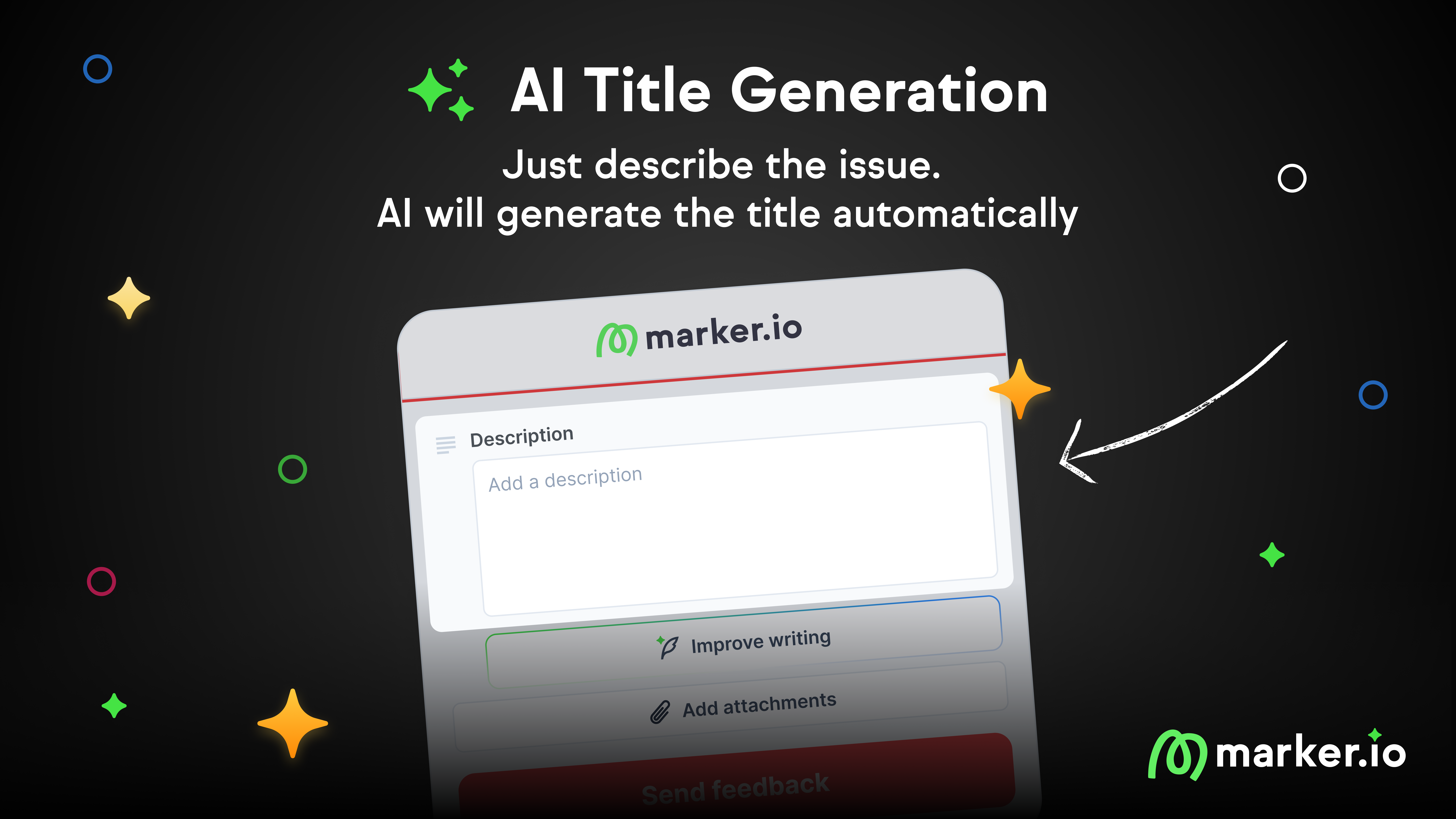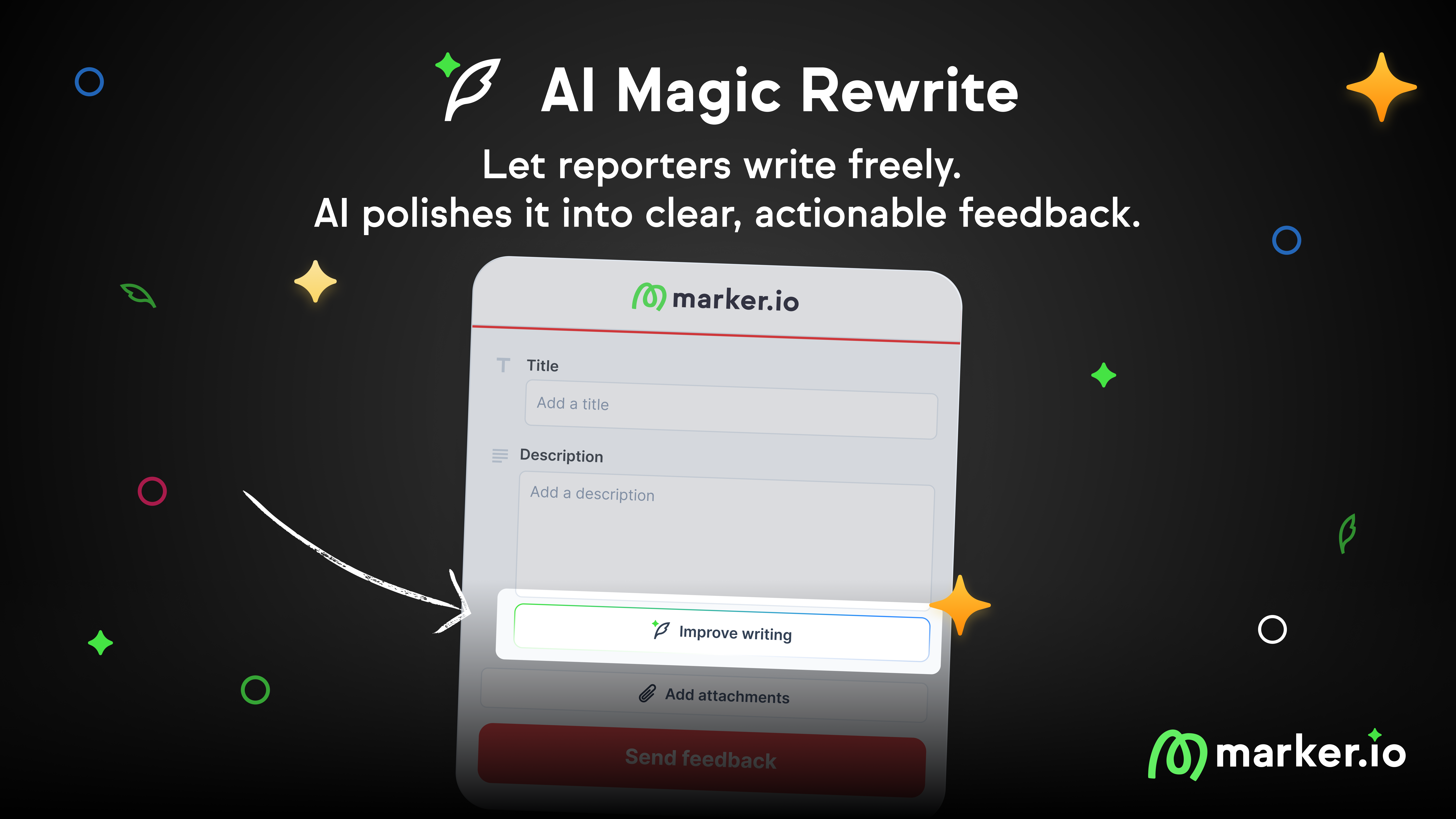User Feedback: Top Tips for Product Developers
Why is user feedback so crucial for product developers? In this article, we answer that question—and more—on collecting and managing feedback.
Most people would agree feedback is important. Getting feedback from your customers is always useful, isn't it?
Why is feedback so crucial for product developers, though? Typically, developers aren’t directly in charge of feedback management.
In this article, we’ll answer that question. We’ll also illustrate how product developers can build the most impactful features with the help of user feedback. Let’s begin!
What is user feedback?
User feedback is any commentary your users share about your product and their customer experience. Feedback can come from:
- Reviews
- Feature requests
- Bug reports
- Social posts
- Chatbot inquiries
- Sales calls
- Emails
- Customer survey responses
- And more
In most organizations, product managers, customer support, and customer success managers are in charge of managing user feedback.
Product developers have a lot to gain from this feedback, though. They can find out:
- How users feel about a new feature
- What kind of features they really value
- What bugs they encounter
- What features are missing and stopping new business
- The pain points behind feature requests
- Clarification on how to best build the feature
This information can clarify what truly matters to users. Armed with that knowledge, product developers can build better products.
Let’s dive a little deeper into feedback sources.
Sources of feedback
Feedback often comes from many sources. It’s important to have a centralized place for all feedback. Only then can you truly make sense of it. Here are a few common feedback sources.
1. Existing customers
Your customers are the primary users, so their feedback is invaluable.
Depending on the nature of your app, you might have only paying customers, only free users, or a combination of both. Knowing what paying versus free users value is very important.
For example, you might find yourself in the following situation.
- 10 free customers really want feature A
- 5 paying customers really need feature B
If you were only judging the feature’s importance by the number of requests, you’d prioritize feature A. Which is probably a very valuable feature! However, this feature won’t positively affect your ARR.
You can give your existing customers an easy, in-app way to submit feedback (via a widget, Intercom, or other third-party tool). This will help you understand their needs better.
2. Potential customers
Speaking of ARR, building features that help close deals has a direct impact on your bottom line.
When you know what your leads and prospects want, you can prioritize those features to help win more deals.
To gather feedback from prospects, you need to empower your sales team. Give them a way to pass on those feature requests (more on this below!).
3. Review sites and social media
People like to talk. Especially when they’re unhappy about something.
If you go to any big tech company’s social page, you’ll probably see many comments about something not working. Same with review sites like G2 and Capterra.
This might be true for your app too. So work with your marketing team to find out what people are saying about your tool online. You might find some really useful insights there!
Sometimes, you may even find some actionable tips and suggestions among those reviews. Use them to your advantage!
4. Internal conversations
Don’t forget to ask your team for feedback too! Your teammates can be a goldmine when it comes to feedback. They care about your tool, likely use it, and have an opinion.
Give your team a way to share feedback with you. Maybe it’s a separate Slack channel, a meeting, or an internal feedback board. Whatever helps your communication flow.
Now that you know where to look out for feedback, let’s discuss different types of feedback.
Types of feedback
Some people submit feedback to help you improve your product. Others – because something upset them. Let’s distinguish between these types of feedback. This will help to understand what kind of feedback is useful for your product development process.
1. Positive feedback
Of course, we all want praise and props. When we get glowing reviews online and positive NPS scores, we all do a little happy dance.
However, we need to ask ourselves: is this feedback really useful?
It helps our brand's reputation, validates our decisions, and simply makes us feel good.
Still, it does little in the way of helping us improve. So let's celebrate and move on to constructive feedback.
2. Constructive feedback
This is where the magic happens. If you pay close attention to this type of feedback, you’ll get amazing insights.
Constructive feedback includes feature requests, bug reports, and other helpful information from your audience. Users who genuinely care about your product usually submit this type of feedback.
That’s because they use your tool, and it’s in their best interest to help improve it.
When someone tells you something's broken, they do you a favor. When they suggest a way to improve, they’re helping you shape and improve your product.
So spend time analyzing this type of feedback. Let your customers in on this journey. Share your product development process with them, set expectations, and thank them for their input.
3. Negative feedback
Unfortunately, you can’t escape it. Even if you don’t actively encourage feedback, you’ll get unhappy users. And some of them will share their feedback publicly.
Rather than getting upset, use this as an opportunity! Sometimes complaints from unhappy customers contain useful ideas for improvement.
Other times they’re just descriptions of issues that you can’t resolve, at least right now. Take this feedback, thank them, and also move on. You’ve got bigger fish to fry!
Let’s go over collecting that feedback.
How to collect feedback
Here are a few ideas to help you collect feedback.
Traditional methods
These are your typical surveys, focus groups, and customer interviews. You’ve likely done or thought about these.
Surveys can include:
- NPS (net promoter score) – how likely are customers to recommend your business
- CSAT (customer satisfaction) – how pleased your customers are with your product or service
- CES (customer effort score) – how difficult it was to solve a customer’s issue
Focus groups help you dive a little deeper into your customers’ insights. They’re more complicated to organize and typically cost more. Processing results from focus groups is also tough: most of the data you get is qualitative.
Customer interviews are great because they are typically done one-on-one. You can explore a customer’s unique use case and hear from them directly.
Modern methods
As great as traditional methods are, there are some modern alternatives that save time.
For example, you can ask for the same NPS score, but inside your app. Users won’t need to leave the app and open up a survey. It’s much easier for them!
There are also feedback widgets. You can embed them into your site and display existing feedback. By doing that, you’ll invite more feedback.
Help desk tickets and customer support chats are great sources of information. When a client reaches out to you, it’s a clear indication that you should look into this issue. If they’re reporting a missing feature, it only makes sense to add their request to your list.
Sales conversations can also contain lots of feature ideas.
“I’d definitely buy this tool of only it could do X,” – a lead might say.
A sales rep can track that feedback, attach potential MRR to it, and send it to your product team.
When a tool is built into your system, it’s often easier to process the results too.
Feedback tools
Finally, there are dedicated feedback tools. Consider these when you're serious about feedback (and time saving). They help you collect and keep all feedback in one place. It’s easier to make product decisions based on feedback this way.
Depending on the tool, you can also prioritize ideas, build a roadmap, and announce updates. Examples of these tools include Marker.io, Canny, Hotjar, etc (more on them later in the article).
We’ve discussed some popular feedback collection methods. But what questions should you ask to get the most useful feedback?
Questions to ask when collecting feedback
The way you phrase your questions makes a huge difference. Questions determine the quality of answers. And the last thing you want is to get unusable responses.
Here are some effective questions you can ask your users.
Open-ended questions
- What are you trying to achieve by using our product?
- What challenges led you to try our product?
- How did you find our registration process?
- Is there anything you would change?
- Is there anything that prevents you from using our product?
- What aspects of our product do you like?
- What aspects of our product would you change?
- What improvements would you suggest?
- How is your overall experience with our company?
- Is there anything else you would like to share?
“Pick one option” questions
1. CSAT Survey question: How satisfied are you with our product?
- Very satisfied
- Satisfied
- Neutral
- Dissatisfied
- Very dissatisfied
2. CES Survey question: How easy or difficult is it for you to solve your issue with the help of our product?
- Very easy
- Easy
- Neutral
- Difficult
- Very difficult
3. NPS Survey question: On a scale from 1 to 10, how likely are you to recommend our product to others?
- 1 to 10 scale
4. How responsive are our customer service representatives?
- Very responsive
- Responsive
- Neutral
- Unresponsive
- Very unresponsive
Product experts agree that open-ended questions often yield the best results.
Remember only to pick the questions that help you achieve your immediate goals. Don’t bombard your customers with all the questions at once!
Once you’ve gathered feedback, it’s time to analyze it.
Analyzing and actioning feedback
Getting all the data from your feedback collection might be overwhelming. What are you supposed to do with all this information? Let’s go through it.
1. Categorizing & prioritizing
Like we mentioned above, the best way to make sense of your data is to first put it all in one place. Some teams choose to do it in a spreadsheet, a Notion doc, or a feedback management tool.
When it’s all in one place, it’ll be easier to see patterns. You can categorize your feedback by users who submitted it, potential MRR of features, effort score, or something else. The choice is yours! And your prioritization formula should be unique. Only you know what matters most to your organization.
2. Making data-driven decisions
This is what feedback management is all about. Its aim is to help you select winning ideas.
When you know that a certain feature will bring you new business, it makes sense to prioritize it (even if the effort level is high).
If many of your paying customers are reporting the same bug, you should probably look into it soon. You can also address their feedback to let them know you've heard them and will work on it.
The bottom line is this: it’s easy to fall in love with your own ideas. After all, you built this tool, so you know best what it’s missing, right?
Well, sometimes. But it’s important to keep your eyes on the prize. And customer satisfaction and loyalty are the ultimate prize.
3. Closing the feedback loop
It all comes down to this. You need to demonstrate to your audience that you heard them and implemented their ideas. When you do that, customers like and trust you more. It’s that simple.
It’s one thing to just collect feedback. But adding features that your users specifically asked for? That’s a whole different story.
Put yourself in the shoes of your customers for a second. Imagine an app that you love and use every day. Because you know it so well, you get an idea for improving it.
You submit that idea and see others support it. This is already a great feeling!
Then you see that this new feature is in development. One day, you wake up and see a changelog update – it’s now live! How amazing would that feel?
This is the exact feeling you can give to your customers.
Now, let’s explore some use cases for the different types of feedback you’re collecting.
Use cases
How can you use that feedback and actually build better products? Let’s illustrate some of the advice we’ve given you so far.
Beta testing
When testing your product or features, feedback is vital. You need to understand exactly what’s working and what’s not.
A tool like Marker.io is crucial. Users can easily add comments and suggestions, take screenshots, report bugs, and more when testing websites.
Marker.io makes it easy for beta testers to submit feedback. People are much more likely to share their thoughts when this process is so seamless.
You can also take note of the actions people take on your site. It’s common for people not to use the tool or website the way your team envisioned it.
Sometimes, people “misusing” your website or certain features in your app can lead to cool ideas. Users may be trying to click on a section that isn't clickable. And perhaps it should be? So take note of that user behavior!
Bug reporting
No matter how much you test, you won’t be able to eliminate all bugs. Tracking them is so important!
You’re likely not the primary user of your app. So give the power of tracking bugs to your users!
Marker empowers you to do that too. When a user notices a bug, they can easily take note of it and send it to your team. All that’s left to do is fix it.
Canny is another excellent tool for bug reporting. Users can submit their bug reports, and Canny will help you prioritize all requests in one place.
Once you fix those bugs, your users will get an automatic notification about it.
Feature requests
Your dedicated and loyal users will send you ideas for improvement.
It’s easy to lose track of them, though. When they’re coming from all the different places, it quickly gets out of hand.
For example, some users may be tweeting at you with their feature requests. Others could be emailing you. And someone else is sending ideas through your surveys.
You’ll quickly realize that you need a tool to manage it all. If you’re truly committed to actioning user feedback, you can try a tool like Canny.
With Canny, all of your feedback has a home. Users submit their ideas, vote and comment on existing ones, and chat about them.
They’ll see what’s on your roadmap and get automatic notifications about progress.
Surveys
We mentioned surveys a few times throughout the article. They’re still an awesome way to gather feedback! And there are great tools to help you make your surveys even better.
Hotjar is an outstanding example. They now offer AI-powered surveys, so creating them takes minutes.
After you receive responses, Hotjar will help you process the results.
You also don't have to email survey requests. You can embed those surveys into your website, where they’re the most relevant.
For example, a survey prompt may pop up after a user takes a particular action. This will increase the submission rate and will give you more valuable insights.
How feedback can help developers
We've covered a lot about feedback. We hope you see how feedback can move the needle in your product development process.
User feedback is really invaluable for product developers.
By effectively collecting and analyzing feedback, you can refine your products, prioritize features, and meet user needs and expectations. Moreover, you can find gaps in your product and delight your users.
Start tracking user feedback today!
What should I do now?
Here are three ways you can continue your journey towards delivering bug-free websites:
Check out Marker.io and its features in action.
Read Next-Gen QA: How Companies Can Save Up To $125,000 A Year by adopting better bug reporting and resolution practices (no e-mail required).
Follow us on LinkedIn, YouTube, and X (Twitter) for bite-sized insights on all things QA testing, software development, bug resolution, and more.
Frequently Asked Questions
What is Marker.io?
Who is Marker.io for?
It’s perfect for agencies and software development teams who need to collect client and internal feedback during development, or user feedback on live websites.
How easy is it to set up?
Embed a few lines of code on your website and start collecting client feedback with screenshots, annotations & advanced technical meta-data! We also have a no-code WordPress plugin and a browser extension.
Will Marker.io slow down my website?
No, it won't.
The Marker.io script is engineered to run entirely in the background and should never cause your site to perform slowly.
Do clients need an account to send feedback?
No, anyone can submit feedback and send comments without an account.
How much does it cost?
Plans start as low as $39 per month. Each plan comes with a 15-day free trial. For more information, check out the pricing page.
Get started now
Free 15-day trial • No credit card required • Cancel anytime











